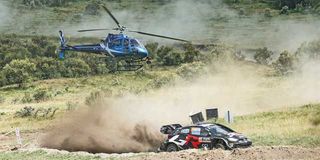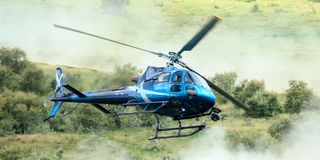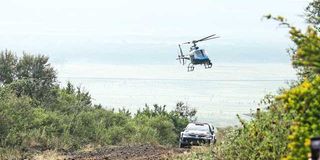Premium
Helicopter route opener: Keeping man, animal safe during WRC Safari Rally

Takamoto Katsuta navigated by Aaron Johnson on a Toyota Yaris monitored by the WRC Live chopper at Hellsgate stage on March 31,2024 during the WRC Safari Rally.
They were the guiding angels on wings, or rotors if you like, shepherds from the skies who manoeuvred rally cars throughout the four days of the WRC Safari Rallying last weekend in a well synchronised operation.
The aerial assistance was relayed to the rest of the world through Rally.TV, the London-based station that beamed the action in Naivasha to a global television audience of 82 million last weekend.
These ace aviators from Nanyuki-based Tropical Air Kenya were the warning shot to spectators of an approaching rally car. The speeding vehicle , accompanied by a navy blue helicopter carrying a pilot, co-pilot and cameraman, and sometimes an observer as the images captured mixed with ground anchors voice over were transmitted to Rally.TV studios for editing and released to 50 linear TV stations in 150 countries in real time, thanks to a pool of local ace aviators.
With only the rotor and camera mounted on the front doing 360 degrees movements, the chopper was also a route opening -- “sweeper” -- that alerted animals of the presence of humans and their machines activities in the natural habitat.

WRC Live chopper monitors the Hellsgate stage on March 31, 2024, during the WRC Safari Rally.
That blue chopper is now an internet sensation and Kenyans on social media are asking who are these daredevils who did what appeared to be suicidal stunts that scared residents of Soysambu, the stubborn zebras, giraffes and buffaloes into behaving and keeping off the rally route.
As a testament to their superb work, no spectator or animal was injured or killed during the rally.
The zipping and zapping helicopter could do everything and anything that defied gravity, sometimes flying above the car, sideways and sometimes so low the landing skids almost touched the ground.
There are no major modifications made on the helicopter with the exception of a small hole cut into the belly panel cowling to accommodate the mounting points between the helicopter and the pole that holds the camera.
“As Tropic Air is actively involved in aerial filming, all of our helicopters are able to accommodate a variety of camera mounting systems. Each camera mounting system must have a Supplemental Type Certificate (STC) issued/approved by the relevant Civil Aviation Authority and applicable to the aircraft type,” Tropical Air Kenya Chief Helicopter Pilot Timmy Flowers said.
The aviators and the chopper were an entertainment in themselves, a spectacle unfolding ceaselessly, pushing the flying machine within the frontiers of its engineering capabilities but skilled to a fault and disciplined enough to remain safe on location and deliver the assignments at hand with laser beam accuracy.
The pilots requested that they remain anonymous in the spirit of team work at Tropical Air for the purpose of this article.
They are not heroes or supermen, said the chief helicopter pilot in a statement.
“Tropic Air does not care to individualise pilots for missions flown. All projects undertaken reflect equally on Tropic Air and the company commitment to safety, training and continual improvement. As each and every helicopter task is unique and demanding,” he added.
There was just one filming helicopter contracted for aerial filming at the Safari Rally though there can be up to five additional helicopters including for medical, safety, WRC Promoter and Organising Committee.
“Over the last four years the Pilot in Command of the filming helicopter has been allocated to four different Tropic Air Pilots. The 2024 edition was commanded by a Kenyan. All pilots are full time employees of Tropic Air,” said the statement from Tropical Air Kenya.

Kalle Rovanpera, navigated by Jonne Halttunen in a Toyota Yaris, closely monitored by the WRC Live chopper, competes on the Malewa stage on March 31, 2024, during the WRC Safari Rally.
The highly skilled pilots are renowned for flying in filming teams from respectable organisations such as the BBC, National Geographic and Disney. They are professionals who are always on standby for unexpected find and rescue medical evacuation around Mt Kenya.
“It is incorrect to refer to manoeuvres demonstrated as crazy,” corrected the spokesperson. “This insinuates lack of control. All manoeuvres must be within the limitations stated by the aircraft manufacturer. A thorough recce of the race track is conducted prior to conducting live filming,” said Flowers.
This means going through the entire Safari Rally route of 367km. Additional kilometres are logged to identify hurdles and geographical features.
“This ensures obstacles are identified and means the pilot can establish the best positioning and intended movement of the aircraft in relation to the track, cars and obstacles in order to capture the necessary shots in a dynamic and fluid motion. Locations for initial pilot training are varied.”
This is achieved easily in the WRC Safari which is held in what the pilots consider their natural habitat -- wildlife-teeming African Savannah.
“Tropic Air Pilots allocated to the WRC filming helicopter must be familiar with low level flying. This experience is generally gained during training for game (wildlife) operations and subsequent missions including darting, herding and capture. All low level flying operations within built up areas or over large gatherings of people require written permission from the Kenya Civil Aviation Authority.”
Planning, and also taking decisions on the ground are also a mark of distinction for these pilots.
Asked if covering the WRC Safari was just another day in the office, Flowers responded: “ It is improper to consider any task as ‘just another day in the office’ as this insinuates a level of complacency which must not occur in aviation.
Aerial filming at an event such as the Safari Rally, where everything is fast moving and dynamic, combined with operating in a low level environment where wires, trees and birds present a great hazard, means that the overall level of risk is significantly higher than on say one of our tourism flights in the North of Kenya,” said the spokesperson.
“This means that additional time and attention is required to identify the hazards and apply mitigation measures to ensure that the risks of a given hazard are eliminated or at the very least, reduced to an acceptable level. An example would be flying the course prior to the cars to establish visual markers, where, upon reaching, the pilot might increase height to avoid power lines."
Locally raised, but trained in the United States, the pilots face all sorts of challenges and new learning opportunities.
“USA has been a popular destination for initial flight training amongst Tropic Air pilots. However, specialised task training and checking is conducted in-house by the company training captains/ Design Check Pilots,” Flowers explained.
Training makes it perfect. Now filming the Safari Rally has become routine. “Tropic Air has been providing the filming helicopter for the WRC Safari Rally since 2021. In that time two pilots have been Kenyan, one Ugandan and one British. The camera operator, who specialises in the operation of the aerial camera system is a foreign national,” he added.
The WRC Promoter, the commercial and media rights holder of the FIA World Rally Championship (WRC) ,didn’t need to look far when shopping for competent pilots to fly its filming crew.
Tropical Air pilots are renowned worldwide having undertaken Hollywood movie productions and television documentaries for National Geographic, BBC, The Lion King, Planet Earth, Africa, Life, Dynasties respectively.
Covering the Safari rally for the helicopter operator goes beyond commercial considerations in the Safari.
“Having the Safari Rally established as a WRC calendar event in this modern era of live internet broadcasting is simply a great opportunity for showcasing Kenya to a large global audience. It is also a visual testament to the international communities that Kenya has the resources and professional capability to host events of this scale,” he said.
“Tropic Air benefits both directly as an official supplier to the event but will also, like many Kenyans, benefit from downstream opportunities that may arise, for example an increase in the number of tourists visiting Kenya may result in us taking more international guests to the more remote Kenyan locations and in turn benefiting those local communities.
Said Flowers: “The Safari Rally to us is not just a helicopter flying around chasing rally cars, it is the culmination of many months of logistical planning, communications with local organisers and procuring entities, risk identification and mitigation all for the end result of hopefully capturing the best possible aerial perspectives of this incredible event.
“Provided everyone is safe, our clients are happy and we have been able to play our part in showcasing the very best of what Safari Rally and Kenya is to a global audience - then we are happy.
“These pilots are also revered, loved and respected in Nanyuki for their humanitarian work which is both mentally, physically and emotionally draining.“
Tropic Air’s positioning directly below Mt. Kenya means they are the first point of contact for all helicopter evacuations on the mountain.
Tropic conducts up to 30 rescue missions a year ranging from cases of Acute Mountain Sickness (AMS) to trauma injuries caused in falls, the spokesperson elaborated.
“These rescues range in height from 10,000ft to over 16,000ft. Unfortunately over the years, Tropic Air have also been involved in a number of body recoveries which can often be more challenging. In 2017 Tropic Air assisted KWS with the recovery of the body of a Chinese who lost his life in a fall during descent from the summit of Batian.” Flowers revealed.
Away from the Safari and medical evacuation missions, these pilots are at home in their natural habit amongst wild animals which has created an extensive knowledge and experience. “By nature of Tropic Air’s location in Nanyuki, Lakipia and being surrounded by National Parks and Private conservation areas, all pilots have many hours of experience in wildlife work.
Flowers says they provided services to KWS and conservancies that want to dart, herd and capture game.
“This work forms a big and much enjoyed part of our services and carries similar characteristics such as method planning and skills required for aerial filming for the Safari Rally.”
Despite their terrific work, Flowers remains modest to the end.
“The reason we all tune in and turn up is to watch the real stars of the show, which are the incredible drivers and teams pitting their machines against the clock, the elements and each other.”





